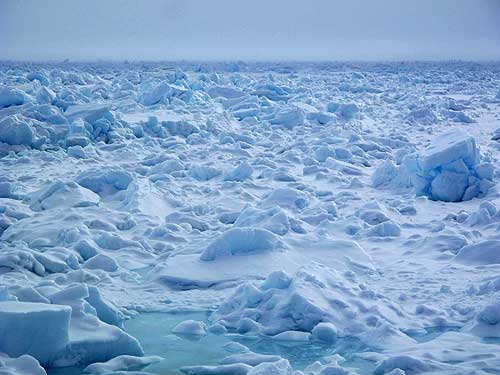
By NED ROZELL March 15, 2011
This reduction in size of the frozen platform habitat of polar bears and seals has a group of scientists thinking of the future. A few researchers have mapped an area they believe will be a “sea-ice refuge” if and when the rest of the summer ice goes away.
Sea ice north of Barrow.
Prevailing winds stack up sea ice along shorelines in northern Canada and Greenland in an area that also lies beyond the pull of powerful ocean currents. “It’s the last place sea ice would be,” said Stephanie Pfirman of Columbia University, who wrote a paper on the “naturally formed sea ice refugium.” This sliver remaining of a continent of ice has inspired researchers - including Anchorage polar bear specialists George Durner and Steve Amstrup, and seal specialist Brendan Kelly, formerly of Juneau - to look ahead to the end of this century. The following scenarios are possible, if not likely by 2100: shipping lanes are wide open during arctic summers, the oil and gas beneath the surface of the Arctic Ocean is tapped by drilling rigs, and polar bears and seals cling to a fragment of habitat. Biologists, sea-ice specialists and computer modelers have collaborated to see what is needed to protect the last stand of summer sea ice. Any preservation scheme needs to involve several countries and the prediction of where the refuge sea ice is generated. It also requires researchers to think about the future, and about how to convince others to join them in doing so. “Having a 100-year plan is new territory for resource managers,” said Kelly, who now works for the National Science Foundation as the deputy director of its Arctic Sciences Division in Arlington, Virginia. Kelly has studied ringed seals in the Arctic, a favorite food of polar bears. Using computer models and observations, he determined that by the end of this century, ringed seals will not be able to find enough snow to make snow caves in which to have their young, except in isolated parts of the Canadian Archipelago. “Concentrating birth lairs of ringed seals in the limited areas where snow depth will be adequate may increase their vulnerability (to polar bear predation),” Kelly said. In December, Kelly commented in the journal Nature on the potential for increasing hybridization between polar bears and grizzly bears. A few intermingled polar and grizzly bears have already been found. Kelly claims that if polar bear populations decline, hybridization with grizzly bears could doom the great white bear. “If polar bears survive climate change in secluded refuges - which is far from certain - interbreeding could be the final straw,” he wrote. As he addressed reporters at the American Geophysical Union meeting, Kelly wondered aloud whether the sea ice refuge would come to exist sooner or later, and how animals that thrive on ice would react when their world is reduced to an island of ice. “Is the rate of which this environment is changing more like continental drift or a meteor strike that will change things overnight?” he asked.
This column is provided as a public service by the Geophysical Institute, University of Alaska Fairbanks, in cooperation with the UAF research community. Publish A Letter in SitNews Read Letters/Opinions
|
||
